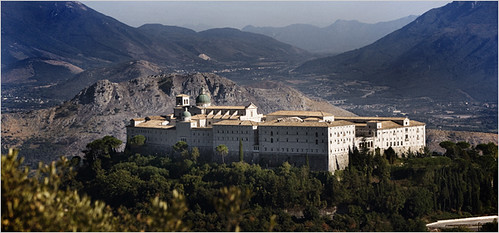That village is San Pietro, an "11th-century cobblestone mountain village nestled among wild figs and cactus," as well as the scene of months of horrific fighting between Allied and German troops.
 [Image: The reconstructed abbey atop Monte Cassino, as photographed by Stephanie Kuykendal for The New York Times].
[Image: The reconstructed abbey atop Monte Cassino, as photographed by Stephanie Kuykendal for The New York Times].Nearby, atop Monte Cassino, was "one of the holiest sites in Christendom," a monastery "founded by St. Benedict in the sixth century, a shrine of Western civilization" – indeed, "a center of art and culture dating back nearly to the Roman Empire" – which the Allies bombed into rubble, suspecting (or not suspecting, but caught up nonetheless in the machinations of bad intelligence and unquestioned orders) that German troops had taken refuge there.
"After the battle ended," we read, the entire chain of small mountain valleys in which San Pietro once stood "would be left uninhabitable for years, demolished by Allied bombs, beset by malaria."
So this may be a bit rambling, and otherwise unrelated, but while working on The BLDGBLOG Book tonight (due out Spring 2009! from Chronicle Books! buy loads!), I was re-reading W.G. Sebald's extraordinary On the Natural History of Destruction.
At one point in the book Sebald describes the literally shell-locked life of people who had managed to stay on in the destroyed cities of northern Germany during WWII. He describes "the unappetizing meals they concocted from dirty, wrinkled vegetables and dubious scraps of meat, the cold and hunger that reigned in those underground caverns, the evil fumes, the water that always stood on the cellar floors, the coughing children and their battered and sodden shoes."
Battling grotesquely bloated rats and enormous green flies, these "cave dwellers," as Sebald calls them, lived with the "multiplication of species that are usually suppressed in every possible way," amidst the gravel and shattered windowframes of their now "ravaged city."
Based on an eyewitness account written by an Allied Air Commander, Sebald then refers to "the terrible and deeply disturbing sight of the apparently aimless wanderings of millions of homeless people amidst the monstrous destruction, [which] makes it clear how close to extinction many of them really were in the ruined cities at the end of the war."
For some reason the next line just haunts me:
- No one knew where the homeless stayed, although lights among the ruins after dark showed where they had moved in.
What "monstrous destruction" of world war and oil shortages and global terror and climate change might we, too, have to face someday?
In twenty years' time will I be out holding up some pathetic light among the ruins of a destroyed city, wondering where my wife is, dying of thirst, deaf in one ear, covered in radiation burns?
Or is that just a peculiarly American form of pessimist survivalism? Or do I just read too much Sebald?
No comments:
Post a Comment